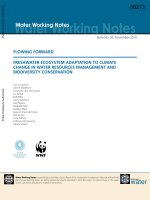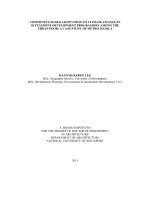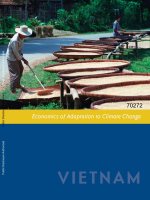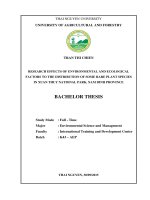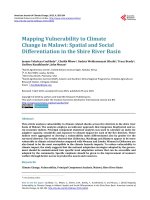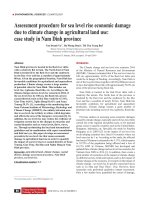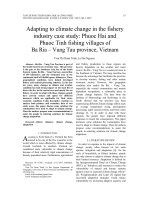VULNERABILITY ASSESSMENT OF ECOSYSTEM TO CLIMATE CHANGE IN XUAN THUY NATIONAL PARK
Bạn đang xem bản rút gọn của tài liệu. Xem và tải ngay bản đầy đủ của tài liệu tại đây (4.78 MB, 72 trang )
MINISTRY OF AGRICULTURE AND RURAL DEVELOPMENT
VIETNAM NATIONAL UNIVERSITY OF FORESTRY
----------o0o----------
STUDENT SCIENTIFIC RESEARCH REPORT
VULNERABILITY ASSESSMENT OF ECOSYSTEM TO
CLIMATE CHANGE IN XUAN THUY NATIONAL PARK
Supervisor: Assoc.Prof. Tran Quang Bao
Student: Mai Phuong Thao
Nguyen Lan Huong
Class: 59 Natural Resource Management
Major: Natural Resource Management
Hanoi,
Faculty: Forest
Resource and Environmental Management
April
Hanoi, April 2017
CATEGORY
LIST OF TABLES.....................................................................................................ii
LIST OF FIGURES..................................................................................................iii
PREFACE.................................................................................................................. 1
Chapter 1: INTRODUCTION...................................................................................2
1.1
The urgency of the problem.............................................................................2
1.2.
Research goal..................................................................................................3
1.3.
Research objects..............................................................................................3
1.4.
Scope and boundary........................................................................................3
Chapter 2: LITERATURE REVIEW.........................................................................4
2.1
The concepts....................................................................................................4
2.2.
In the world.....................................................................................................5
2.3.
In Vietnam.......................................................................................................5
4. Studies on the impact of climate change.............................................................8
Chapter 3: CONTENT AND METHODS...............................................................10
3.1.
Research content............................................................................................10
3.2.
Research methods..........................................................................................13
Chapter 4: XUAN THUY CHARACTERISTICS...................................................21
4.1
. Natural conditions.......................................................................................22
4.2.
Economic conditions, social..........................................................................26
Chapter 5: RESEARCH RESULTS.........................................................................28
5.1
Baseline and exposure...................................................................................28
5.2
Sensitivity......................................................................................................39
5.3
Impact identifying......................................................................................45
5.4
Adaptive capacity.........................................................................................1
5.5 Vulnerability......................................................................................................11
Chapter 6: RECOMMENDATIONS FOR ADAPTATION RESPONSES................1
6.1
Non-structured recommendations....................................................................1
6.2 Structured recommendations...............................................................................2
Chapter 7: CONCLUSIONS.....................................................................................3
REFERENCES..........................................................................................................5
LIST OF TABLES
Table 1: The sub-indices of the main index in World Bank vulnerability assessment
to climate change for Vietnam aquaculture sector.....................................................6
Table 2: Exposure factors........................................................................................10
Table 3: Sensitivity factors......................................................................................11
Table 4: Impacts matrix...........................................................................................17
Table 5: The vulnerability matrix............................................................................19
Table 7: Monitoring changes in number individuals of 7 indicator migratory species
within 3 periods of time...........................................................................................40
Table 8: Climate changes impact on selected plant indicators species in Xuan Thuy
National Park...........................................................................................................42
Get the Exposure and sensitivity result and find in Exposure column and Sensitivity
row. The intersection cell is the Impact level. For example:....................................45
Table 11: Comparing Forest management efficiency (forest area change)................2
Table 12: Results of the survey on community participation in mangrove protection
and development........................................................................................................3
Table 16: Coastal adaptive technology......................................................................3
LIST OF FIGURES
Figure 1: Social Determinants of Adaptive Capacity chart......................................12
Figure 2: CAM methodology steps..........................................................................14
Figure 3: Vulnerability assessment..........................................................................15
Figure 4: Location of Xuan Thuy National Park.....................................................21
Figure 5: Baseline and change in precipitation in wet season in 2050 (Jun-Nov)....31
Figure 6: Baseline and change in precipitation n a dry season in 2050 (Dec – May)
................................................................................................................................. 32
Figure 7: Baseline and change in average daily maximum temperature in a dry
season in 2050 (December – May)..........................................................................34
Figure 8: Baseline and change in average daily maximum temperature in wet season
in 2050 (Jun – Nov).................................................................................................36
Figure 9: Baseline and change in average daily maximum temperature in wet season
(Jun – Nov) map......................................................................................................38
Figure 10: National Park Administration...................................................................7
PREFACE
Thanks to the agreement of Vietnam National University of Forestry, Forest
Resources, and Environment Management, we conduct scientific research: “Assess the
vulnerability of the mangrove ecosystem to climate changes impacts in Xuan Thuy
National Park”
On the occasion of completing our study, I would like to say thank you to the
administrators of the Vietnam National University of Forestry, all the teacher work in
Forest Resources and Environment Management and Forest Resources and
Environment Center give us a lot of help to complete the research. Especially, we take
this chance to express our profound gratitude towards our supervisor, especially
Assoc.Prof. Tran Quang Bao, who is our adviser for supporting us during all the time
of conducting the research.
Last but not least, we would like to thank our family and friends for their
unconditional support and guidance towards the completion.
[1]
Chapter 1: INTRODUCTION
1.1
The urgency of the problem
Climate changes globally some common terms most prominent in the media
today. Their phenomenon occurrences are different among regions, but we can point
out some general characteristics: increase in temperatures, excessive rainfall in the
rainy seasons, precipitation reduction in the dry seasons, frequent occurrence and
serious level rise in drought and flood, the complex activation of hurricanes, El Niño
happens often with turbid fluctuations.
Global climate change is one of the greatest challenges that human face in the
21st century. It is threatening to the entire ecosystem on Earth. Vietnam is severely
affected by climate change. Climate change influences on natural system, including
human also influence on every artificial systems. Ecosystem is one of the most
vulnerable elements in natural system, especially mangrove ecosystem.
Xuan Thuy National Park is the first Ramsar site in Southeast Asia, inside the
Red river biosphere reserves. Like other mangrove forests, Xuan Thuy National Park
mangrove forest is affected by climate change. It is easy to see the effects of climate
change in this region: losing ecological diversity and disrupting balance internally;
fauna species disappear quickly. Forest structure is damaged and the regeneration
ability of mangrove is very low.
Recognizing the importance of protecting and developing the diversity of
ecosystems in Xuan Thuy National Park in in the era of climate change, we carried out
research on: "The vulnerability assessment of Xuan Thuy national park climate change
on mangrove forest in Xuan Thuy National Park"
KEY WORD: Climate change, CAM method, qualitative, Xuan Thuy National
Park
[2]
1.2.
Research goal
1.2.1 Goal
Determining climate change impacts and the vulnerability of ecosystem in Xuan
Thuy National Park, Nam Dinh Province.
1.2.2 Objective
Applying spatial tools for comparing, defining potential threats and
calculating flood risks area between regions to figure out degree of risks.
Identifying climate change impacts level of ecosystem in Xuan Thuy national
park.
Determining ecosystem vulnerability degree with different risks by assessing
Sensitivity and Adaptive Capacity.
Proposing measures to restore ecosystems based on vulnerability assessment.
1.3.
Research objects
Research object is ecosystem in Xuan Thuy, Nam Dinh Province.
1.4.
Scope and boundary
1.4.1Scope
Focusing on assessing Exposure level, Sensitivity and Adaptive Capacity based
on Climatic changes, Biological respond to climate change and 4 factors in Adaptive
capacity:
Social
factor,
Technology,
Institutional
management
and
Natural
characteristic of ecosystem Xuan Thuy National Park ecosystem, Nam Dinh Province.
1.4.2 Boundary
This research focuses on assessing the impact of climate change and vulnerability
of ecosystem in Xuan Thuy, Nam Dinh Province.
[3]
Chapter 2: LITERATURE REVIEW
2.1 The concepts
the state of the atmosphere at a time at a given place is determined
Weather
by a combination of factors: temperature, pressure, humidity,
wind speed, rain, etc.
the long-term weather, characterized by statistical values (mean,
Climate
probability extremes, etc.) of the meteorological elements
variation in a geographic area. The average period of climate
typically takes place in a few decades
the change of climatic conditions than average and/or climatic
Climate
Change (CC)
Mangrove
fluctuations maintained for a long period of time, usually several
decades or longer. Climate change is caused by human activities
altering the composition of the atmosphere or in land use
exploitation.
a term describing an ecosystem in tropical and subtropical forms
of plant-based complex tidal areas with characteristic fauna.
the degree to which a system is susceptible to, or unable to cope
Vulnerability
(IPCC -2007)
with, adverse effects of climate change, including climate
variability and extremes. The vulnerability is a function of the
character, magnitude, and rate of climate variation to which a
system is exposed. Also, its sensitivity and its adaptive capacity.
Response
Human activities to adapt and mitigate climate change
[4]
2.2.
In the world
There are 2 main approaches:
Impact-based Approaches - approach by impacts related to potential problems
impacts assessment of climate change to the system components in different scenarios.
Vulnerability-based Approaches – approach by assessing social-ecological
sensitivity, adaptability.
"Modeling and Simulation Society of Australia and New Zealand" organization
have applied "impact-based" approach for Victoria's Western Harbor and applied the
"vulnerability-based" approach for Sydney Harbor. The results show that both
approaches provide useful information and can be used internationally. However, for a
vulnerability approach that allows for a variety of sources of information, including
adaptive capacity index, the index is easy to quantify even when the relationships
between the variables are different and not define apparently. The most difficult are the
transformation and quantification for variables in vulnerability assessment (eg
comparison of vulnerability to sea level rise, cost-benefit analysis in the management
area), the vulnerability-base approach is just semi-quantitative. In contrast, impactbased approaches have the potential to provide very accurate quantified information.
However, the advantage of the vulnerability assessment approach is that it clearly
delineates the complexity of the complexity of the E, S, and AC factors, thus
identifying barriers with the ability to adapt (this is very useful for managers and
policymakers).
2.3.
In Vietnam
In Vietnam, IUCN and WWF have carried out a report with chẹck-lists to assess the
climate change vulnerability. However, these checklists do not depict priorities and the
magnitude of problem.
[5]
The World Bank project focuses on assessing vulnerability to climate change for
the aquaculture sector in Vietnam. In the conceptual model, vulnerability index is based
on four factors (Allison model):
Exposure (E)
Sensitivity (S)
Potential impacts (PI)
Adaptability capacity (AC)
The main index is formed and calculated from sub-indices.
Table 1: The sub-indices of the main index in World Bank vulnerability assessment to
climate change for Vietnam aquaculture sector
NO
.
EXPOSURE (E)
SENSITIVITY (S)
ADAPTIVE CAPACITY
1
Sea level rise
Direct Livelihoods
(aquaculture households/
total households)
Poverty (including two subindices: Percentage of people
below the poverty line and the
percentage of monthly
expenditure for aquaculture)
2
Change in average
temperature
Direct labor (aquaculture
labor /total labors)
Infrastructure (percentage
telephones/100 people and the
number of beds in hospital/100
people
Change in
precipitation
Macro-economic (the
percentage of
aquaculture
revenue/GDP (share
aquaculture GDP)
Education (% high school
students graduated)
Extreme event
Food security-the
average aquaculture
consumption/capita
(aquaculture income)
Social Capital
3
4
[6]
5
The magnitude and
frequency of
extreme events
6
Flood
Education (% fishing men
trained)
[7]
Normalization of indicators and synthesis.
All of the variables in vulnerability indices are normalized to a range of 0 to 100.
The values of each variable are normalized to the range of values in the data set by
applying the following general formula:
The score is from 0 - 100. The value 100 will correspond to that region with the
maximum value (greatest impact) and 0 will correspond to the region with the
minimum value (the smallest impact).
The vulnerability index is calculated from the equation as follows:
In research, researchers group has been concluded that many of the variables
Where:
V: Vulnerability
E: Exposure
S: Sensitivity
AC: Adaptive capacity
cannot be quantified. The concept of sensitivity, the adaptive capacity index is not
homogenous. The difference in collected data is, also a drawback of the research.
4. Studies on the impact of climate change
There are many researchs had chosen Xuan Thuy National Park for studying. But
most of the researches use the statistical data, modeling and identify the areas can be
flooded due to sea-level rising in Xuan Thuy National Park using scenario. These
methods bring the high accuracy quantitative figures in short-term. However, in longterm, without considering adaptive capacity and other factors may lead to incorrect
models.
[8]
Some researchers had introduced sea level rising as an exposure factor and used
matrix for the ecosystem-base approach; PRA method (Participatory Rural Appraisal)
as tools for recording past extreme event and baseline building. But they just focus on
sea level rising, modeling method for other factors. This method may not suitable for
the inland area because the impact of sea level rising between them is different due to
the difference in exposure. In addition, they have not set up the priorities, because in
some cases, availability of financial and human resources to finish all tasks at once is
not allowed people to mitigate and adapt to sudden events. Also, some scientific terms
and results may cause difficulties for developing planners and decision- makers to
prepare for extreme events.
[9]
Chapter 3: CONTENT AND METHODS
3.1.
Research content
The concept of vulnerability of IPCC (2007): “The degree to which a system is
susceptible to, or unable to cope with, adverse effects of climate change, including
climate variability and extremes. The vulnerability is a function of the character,
magnitude, and rate of climate variation to which a system is exposed; its sensitivity
and its adaptive capacity”.
From this definition, there are 2 main concerns: system 3 types of factors involve
in vulnerability-assessment process:
First concern is system definition and classification.
“A group of interacting, interrelated, or interdependent elements forming a complex
whole. ”
So within a system, the elements and their interactions had their own strength and
weakness. Some components may dominant, some interactions closer than the others.
Natural system is the broadest system, which contains human, animal, ecosystem and
other living and non-living elements.
Human creates Social system, Economic system, Built system and Institutional system.
Human is the element in these systems and the interaction between us depend on the
selected situations.
Second concern is 3 types of factors involve in vulnerability-assessment.
3.1.1 The Exposure factors
These are some external factors influence on both ecosystem and other artificial
systems in Xuan Thuy National Park. For example:
Table 2: Exposure factors
NO
.
INDEX
SUB-INDICATES
[10]
MEANING
The temperature
changes to 2050 in:
1
Precipitation
Dry season
Determining the effect of the
rainfall on the systems
Wet season
2
Determining the impact of the
sea level rise on the systems
Sea level rise
Temperature
changes
3
The temperature
changes to 2050 in:
Dry season
Determining the effect of the
temperature on the systems
Wet season
3.1.2 The Sensitivity factors.
These are some internal factors exist inside these systems.
Table 3: Sensitivity factors
NO
.
INDEX
1
Flora responds to
the climate change
2
Fauna responds to
the climate change
SUBINDICES
MEANING
Monitoring changes of indicator
species in ecosystem
Native species
Monitoring change in number of
native species ecosystem
Immigrants
species
Monitoring the change in number
of immigrant species in ecosystem
[11]
3.1.3 The Adaptive Capacity
The resilience of system to changes. For example of social system.
Figure 1: Social Determinants of Adaptive Capacity chart
[12]
3.2.
Research methods
3.2.1 Methodology
Vulnerability assessment method: using CAM methodology.
ICEM’s CAM – Climate change adaptation and mitigation methodology has been
developed specifically for the Asia Pacific region and has been extensively tested and
adjusted in ICEM projects.
The CAM process illustrated includes five primary steps for adaptation planning
including:
•
Determining the project scope, by identifying the geographic and sector focus
of the assessment and the systems (natural, social, economic, institutional and built)
which will be impacted. Or and addressing their specific sensitivities and adaptive
capacity
•
Conducting a baseline assessment to describe the past and existing situation,
trends and drivers across each of the identified systems, projecting the changes to these
systems which will occur irrespective of climate change.
•
Determining the climate change threats through an analysis of past extreme
events and trends and through climate model and downscaling of future climate and
hydrology against various scenarios.
•
An impact and vulnerability assessment, which includes analysis of the
projected climatic threats to the target systems for defined time slices. The impact
assessment combines the level of exposure of key system components and assets and
their relative sensitivity to the threats. The vulnerability is a measure which considers
the impact and the capacity of the component or asset to adapt to it.
•
Defining adaptation responses: this step includes developing a range of options
for integrated adaptation interventions and then working with stakeholders to
determine priorities – with limited resources it is not possible or necessary to do
everything at once.
[13]
•
Providing
feedback
on
the
adaptation
implementation.
Monitoring
implementation and making adjustments and additions based on experience and new
information are critical to taking a phased and systematic approach to adaptation. The
vulnerability-based approach is more appropriate due to allowing consideration for
human efforts within a specific case. The different region has different policies, distinct
ability with extremely weather phenomena.
Figure 2: CAM methodology steps
[14]
This report focuses on the second and third stages: (i) Identifying the threats from
baseline and (ii) Assessing the exposure, the sensitivity, and adaptive capacity to find
out impacts and vulnerability.
Figure 3: Vulnerability assessment
[15]
3.2.2 Explanations and evidences
This method is a qualitative method or the assessment base on researcher
opinions ad experiences. There are 2 kinds of evidences to prove and explain these
opinions:
1) Using scientific evidence (using secondary data).
Ecosystem vulnerability assessment: using secondary data about fauna and flora,
monitoring and assessing the number of immigrant and native species.
Spatial analysis: GRID raster dataset and GIS techniques (ArcGIS). The baseline
is the modeling data called “Climate model’’, recorded from 2005 to 2012 by
interpolation. This GRID raster built from Climate model by Institute for Meteorology,
Hydrology, and Environment (IMHEN). Using the spatial analysis tools (Tabulate
Area, Geometry Calculate) in GIS to compare exposure level between regions and
calculate the risky area.
2) Understanding and documenting past extremes and trends (based on
stakeholder experience, official records and expert judgment. In many cases, available
information and capacities do not allow for useful science-based projections).
[16]
3.2.3 Impact and vulnerability assessing
Explanations and evidences support the researcher perception. Researcher
responsibility is put them in appropriate levels or qualitative them.
Method of vulnerability qualitative by matrix: refer to ICEM
Impact is identified by the matrix:
Where:
I: Impact
E: Exposure
Table 4: Impacts
matrix
S: Sensitivity
Sensitivity of system to climate threat
Exposure of system to climate threat
5
Very High
4
High
3
Medium
2
Low
1
Very Low
1
Very Low
2
Low
3
Medium
4
High
5
Very High
Medium
Medium
High
Very High
Very High
Low
Medium
Medium
High
Very High
Low
Medium
Medium
High
Very High
Low
Low
Medium
Medium
High
Very Low
Low
Low
Medium
High
This level can be change into point:
0 – 1.5
: Very Low
1.6 – 2.5 : Low
2.6 – 3.5 : Medium
3.6 – 4.5 : High
4.5 – 5
: Very High
[17]
Within Sensitivity and Adaptive capacity, there are some sub-factors with distinct
levels. It is a tough question for researcher to figure out or standardize the final level of
Adaptive capacity or Sensitivity.
Score rank developed from Adaptive capacity and Sensitivity (vulnerability
dimension) is able to cope with this problem. Results were averaged to give an overall
rank:
Rank score = Total of component rank scores / Number of components
However, these given points are relative. But before concluding or taking the
average point to find the result, take an overview to identify the importance and the
occupation of every factor in the system.
[18]
The vulnerability is identified by the matrix:
Table 5: The vulnerability matrix
1
Very Low
1- Very Low
Very limited
institutional capacity
and no access to
technical or financial
resources
2- Low
Limited institutional
capacity and limited
access to technical
and financial
resources
3- Medium
Growing institutional
capacity and access
to technical or
financial resources
4- High
Sound institutional
capacity and good
access to technical
and financial
resources
5- Very High
Exceptional
institutional capacity
and abundant access
to technical and
financial resources
IMPACT
2
Low
3
Medium
3
High
Long term
damage to
system
property or
function
(years)
5
Very High
Inconvenien
ce (day)
Short
disruption
to system
function
(weeks)
Medium term
disruption to
system
function
(months)
Medium
Medium
High
Very High
Very High
Low
Medium
Medium
High
Very High
Low
Medium
Medium
High
Very High
Low
Low
Medium
Medium
High
Very Low
Low
Low
Medium
High
[19]
Loss of life,
livelihood or
system
integrity
Vulnerability index is calculated from equation as follows:
Where:
V: Vulnerability
E: Exposure
This level can be change into point:
S: Sensitivity
AC: Adaptive capacity
0 – 1.5 : Very Low
1.6 – 2.5 : Low
2.6 – 3.5 : Medium
3.6 – 4.5 : High
4.5 – 5
: Very High
[20]
Chapter 4: XUAN THUY CHARACTERISTICS
Figure 4: Location of Xuan Thuy National Park
[21]
